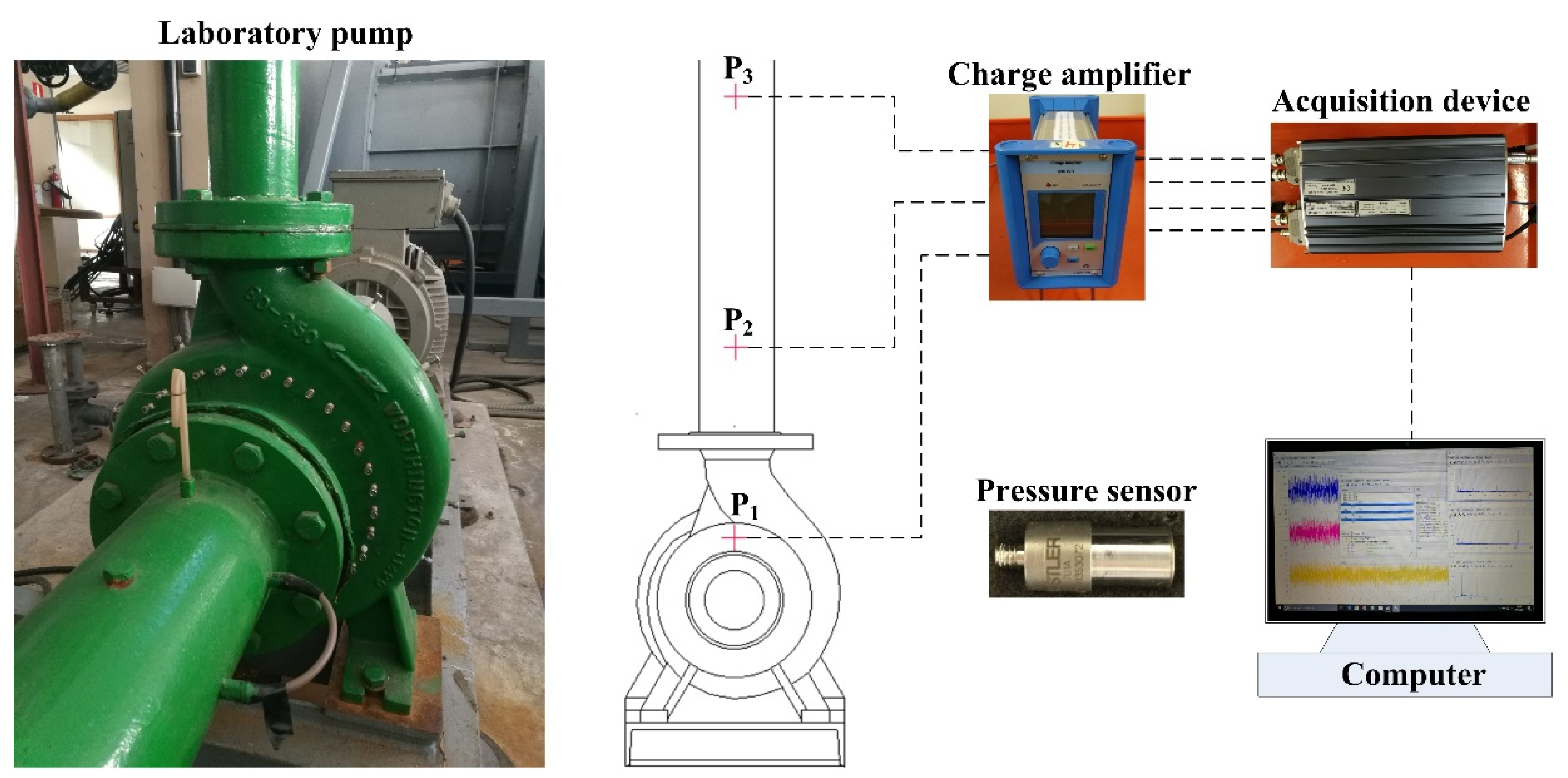Effect of the Discharge Piping Scheme on the Pressure Fluctuations Induced from A Laboratory Pump †
Abstract
:1. Introduction
2. Pump and Experimental Configuration
3. Methodology
4. Results and Discussions
5. Conclusions
Author Contributions
Acknowledgments
Conflicts of Interest
References
- Parrondo, J.; Pérez, J.; Barrio, R.; González, J. A simple acoustic model to characterize the internal low frequency sound field in centrifugal pumps. Appl. Acoust. 2011, 72, 59–64. [Google Scholar] [CrossRef]
- Choi, J.S.; McLaughlin, D.K.; Thompson, D.E. Experiments on the unsteady flow field and noise generation in a centrifugal pump impeller. J. Sound. Vib. 2003, 263, 493–514. [Google Scholar] [CrossRef]
- Guelich, J.F.; Bolleter, U. Pressure pulsations in centrifugal pumps. J. Vib. Acoust. 1992, 114, 272–279. [Google Scholar] [CrossRef]
- Tao, F. The Measurement Study of Flow Induced Noise in Centrifugal Pump. Ph.D. Thesis, Institute of Acoustics, Chinese Academy of Sciences, Beijing, China, 2004. [Google Scholar]


| Point | Shaft Frequency | Blade Passing Frequency | |||||
|---|---|---|---|---|---|---|---|
| Test/Scheme | P1 (Pa) | P2 (Pa) | P3 (Pa) | P1 (Pa) | P2 (Pa) | P3 (Pa) | |
| First Test | Scheme 1 | 82.8 | 166.4 | 145.5 | 1947.2 | 1003.4 | 644.7 |
| Scheme 2 | 86.3 | 163 | 140.7 | 1889.5 | 857.6 | 542.9 | |
| Scheme 3 | 82.8 | 176.5 | 156.3 | 1889.3 | 749.9 | 508.4 | |
| Second Test | Scheme 1 | 89.5 | 156.6 | 133.8 | 2093.9 | 1055.3 | 683.2 |
| Scheme 2 | 76.9 | 154.2 | 134.2 | 1904.9 | 848.1 | 538.7 | |
| Scheme 3 | 75.4 | 178.3 | 158.1 | 1910.7 | 767.6 | 552.8 | |
| Third Test | Scheme 1 | 80.4 | 146.8 | 124.2 | 2094.3 | 1057.6 | 683.7 |
| Scheme 2 | 88.8 | 138.1 | 113.3 | 1943.4 | 848.2 | 540.9 | |
| Scheme 3 | 87.2 | 163.4 | 142.5 | 1910.3 | 849.8 | 655.5 | |
| Point | Shaft Frequency | Blade Passing Frequency | |||||
|---|---|---|---|---|---|---|---|
| Scheme | P1 (Pa) | P2 (Pa) | P3 (Pa) | P1 (Pa) | P2 (Pa) | P3 (Pa) | |
| Scheme 1 | 84.2 | 156.6 | 134.5 | 2045.1 | 1038.8 | 670.5 | |
| Scheme 2 | 84.0 | 151.8 | 129.4 | 1912.6 | 851.3 | 540.8 | |
| Scheme 3 | 81.8 | 172.7 | 152.3 | 1903.4 | 789.1 | 572.2 | |
| Max deviation | 2.93% | 13.77% | 15.04% | 7.44% | 31.64% | 23.98% | |
Publisher’s Note: MDPI stays neutral with regard to jurisdictional claims in published maps and institutional affiliations. |
© 2018 by the authors. Licensee MDPI, Basel, Switzerland. This article is an open access article distributed under the terms and conditions of the Creative Commons Attribution (CC BY) license (https://creativecommons.org/licenses/by/4.0/).
Share and Cite
Li, G.; Parrondo, J.; Wang, Y. Effect of the Discharge Piping Scheme on the Pressure Fluctuations Induced from A Laboratory Pump. Proceedings 2018, 2, 1488. https://doi.org/10.3390/proceedings2231488
Li G, Parrondo J, Wang Y. Effect of the Discharge Piping Scheme on the Pressure Fluctuations Induced from A Laboratory Pump. Proceedings. 2018; 2(23):1488. https://doi.org/10.3390/proceedings2231488
Chicago/Turabian StyleLi, Guidong, Jorge Parrondo, and Yang Wang. 2018. "Effect of the Discharge Piping Scheme on the Pressure Fluctuations Induced from A Laboratory Pump" Proceedings 2, no. 23: 1488. https://doi.org/10.3390/proceedings2231488
APA StyleLi, G., Parrondo, J., & Wang, Y. (2018). Effect of the Discharge Piping Scheme on the Pressure Fluctuations Induced from A Laboratory Pump. Proceedings, 2(23), 1488. https://doi.org/10.3390/proceedings2231488





